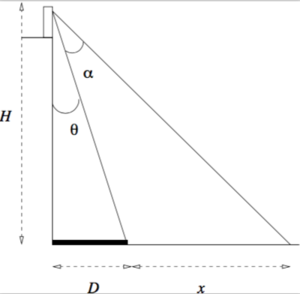Course:MATH102/Question Challenge/2008 December Q9
Appearance
| Questions? Click here to add or read comments for this problem | |
| Please rate how easy you found this problem:
{{#w4grb_rate:}} Hard Easy | |
|---|---|
Question
Graduate student Ryan Lukeman studied the behaviour of duck flocks swimming near Canada Place in Vancouver, BC. This figure from his PhD thesis shows his photography set-up. Here meters is the height from sea level up to his camera aperture at the observation point, meters is the width of a pier (a stationary platform whose size is fixed), and is the distance from the pier to the leading duck in the flock (in meters). is a visual angle subtended at the camera, as shown.

If the visual angle is increasing at the rate of 1/100 radians per second, at what rate is the distance changing at the instant that meters?
Hints
| Hint 1 |
|---|
 |



















